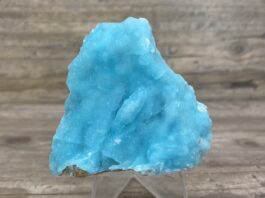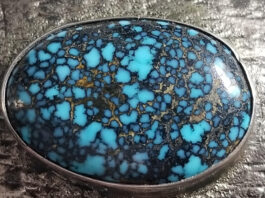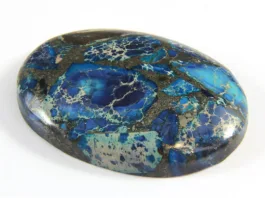Andean Blue Opal, also known as Peruvian Blue Opal is a captivating gemstone found primarily in the Andes Mountains of Peru. It is renowned for its stunning blue hues, which range from delicate pastels to vibrant, deep blues reminiscent of the clear skies and tranquil waters of its native landscape.

This unique gemstone is a type of common opal, composed primarily of hydrated silica with trace amounts of other minerals. Unlike precious opals, which display flashes of iridescent color known as play-of-color, Andean Blue Opal typically exhibits a consistent, uniform blue coloration with occasional translucent or milky patches. Its clarity can vary from opaque to semi-translucent, giving it a captivating depth and allure.
The importance and significance of Andean Blue Opal extend beyond its aesthetic appeal. In Peruvian culture, it is considered a symbol of tranquility, harmony, and emotional healing. Many believe that wearing or carrying Andean Blue Opal can promote feelings of peace, calmness, and spiritual balance. It is often used in meditation practices to enhance relaxation and clarity of mind.

Moreover, Andean Blue Opal holds significance in the realm of crystal healing and metaphysics. It is believed to have various healing properties, including soothing emotional stress, alleviating anxiety, and enhancing communication. Some practitioners also associate it with the throat chakra, believing it can facilitate clear expression and authentic communication.
From a geological perspective, Andean Blue Opal offers insights into the earth’s processes and the formation of gemstones. Its occurrence in the Andes Mountains highlights the region’s rich geological history and the forces that shaped its unique landscapes.
Overall, Andean Blue Opal is not only a stunning gemstone prized for its beauty but also a symbol of inner peace, healing, and connection to the natural world, making it a cherished and significant gemstone in both cultural and spiritual contexts.
Contents
Geological Formation of Andean Blue Opal

The geological formation of Andean Blue Opal is a fascinating process that involves a combination of volcanic activity, hydrothermal processes, and the deposition of silica-rich fluids. Understanding the geological context provides insight into how this captivating gemstone is created.
- Volcanic Activity: The Andes Mountains, where Andean Blue Opal is primarily found, are a result of the subduction of the Nazca Plate beneath the South American Plate. This geological setting is characterized by intense volcanic activity, which plays a crucial role in the formation of opals. During volcanic eruptions, silica-rich magma rises to the surface. This magma may contain dissolved water and other minerals essential for the formation of opals.
- Hydrothermal Processes: As volcanic activity subsides, the silica-rich fluids released during eruptions can percolate through the surrounding rock formations. These hydrothermal fluids can dissolve silica from the surrounding rocks and carry it along fractures and fissures. As the fluids cool and the pressure decreases, they deposit silica in the form of opal, including Andean Blue Opal.
- Influence of Trace Elements: The blue coloration in Andean Blue Opal is often attributed to the presence of trace elements such as copper or colloidal silica particles within the silica structure. These trace elements can interact with the silica matrix, influencing the coloration and transparency of the opal. The specific conditions during opal formation, including temperature, pressure, and chemical composition of the fluids, play a crucial role in determining the color and clarity of the gemstone.
- Deposition and Solidification: Over time, the silica-rich fluids carrying dissolved silica and trace elements infiltrate porous rocks or volcanic ash deposits. As the fluids seep into these materials, they deposit layers of silica gel, which eventually solidify to form opal. The process of opal formation can take thousands to millions of years, depending on the geological conditions and the rate of silica deposition.
In summary, Andean Blue Opal is formed through a complex interplay of volcanic activity, hydrothermal processes, and the deposition of silica-rich fluids. The unique geological conditions in the Andes Mountains provide the ideal environment for the formation of this captivating gemstone, resulting in its distinctive blue hues and tranquil beauty.
Physical Properties of Andean Blue Opal

Andean Blue Opal, like other varieties of opal, possesses several distinctive physical properties that contribute to its allure and uniqueness. Here are some of its notable physical characteristics:
- Color: The most striking feature of Andean Blue Opal is its captivating blue coloration, which can range from pale, sky-like blues to deeper, more saturated hues reminiscent of tropical waters. Some specimens may also exhibit hints of green or turquoise. The coloration is often uniform throughout the stone, although variations and inclusions may create interesting patterns and textures.
- Transparency: Andean Blue Opal typically displays varying degrees of transparency, ranging from opaque to semi-translucent. While some specimens may appear entirely opaque, others allow light to pass through, creating a luminous, ethereal quality.
- Lustre: The lustre of Andean Blue Opal is generally vitreous to waxy, giving the stone a smooth, polished appearance. When properly cut and polished, it can exhibit a soft, glowing sheen that enhances its beauty.
- Hardness: On the Mohs scale of mineral hardness, Andean Blue Opal typically has a hardness ranging from 5.5 to 6.5. While opal is relatively soft compared to other gemstones like diamond or sapphire, it is still durable enough for use in jewelry with proper care.
- Density: The density of Andean Blue Opal can vary depending on factors such as its composition and the presence of inclusions. However, opal generally has a lower density compared to many other gemstones, which contributes to its lightweight feel.
- Crystal System: Unlike precious opals, which exhibit a well-defined crystal structure, Andean Blue Opal belongs to the non-crystalline or amorphous silica group. This means that it lacks a regular crystal lattice and instead forms as irregular masses or nodules.
- Optical Properties: Andean Blue Opal exhibits interesting optical phenomena, including a phenomenon known as opalescence. Opalescence refers to the play of colors or flashes of light that can be observed within the stone under certain lighting conditions. While Andean Blue Opal may not display as pronounced opalescence as precious opals, it still possesses a subtle iridescence that adds to its charm.
Overall, the physical properties of Andean Blue Opal combine to create a gemstone of exceptional beauty and allure, making it a prized choice for jewelry and ornamental purposes. Its unique color, transparency, and optical effects make it a standout addition to any collection.
Locations and Mining

Andean Blue Opal is primarily found in the Andes Mountains of South America, particularly in Peru. Within Peru, some of the key locations where Andean Blue Opal is mined include:
- Queropalca: This region, located in the Andean province of Pasco, is renowned for its opal mines, including Andean Blue Opal. The opal deposits here are found within volcanic rocks and are often associated with hydrothermal activity.
- Carhuaz: Situated in the Ancash region of Peru, Carhuaz is another significant area for Andean Blue Opal mining. The opal deposits in this region are typically found in sedimentary rocks, where silica-rich fluids have infiltrated porous materials.
- Huaraz: Huaraz, also located in the Ancash region, is known for its opal mines, including Andean Blue Opal. The opal-bearing rocks in this area are often found in association with volcanic ash deposits and hydrothermal veins.
- Arequipa: In the southern part of Peru, Arequipa is another notable location for Andean Blue Opal mining. The opal deposits here are often found in volcanic rocks and are associated with past volcanic activity in the region.

Mining Andean Blue Opal involves various techniques, depending on the geological characteristics of the deposits and the scale of operations. Small-scale artisanal mining methods, such as hand digging and tunneling, are common in some areas, particularly in remote regions where access to machinery is limited. In more developed mining operations, mechanized techniques such as open-pit mining and underground mining may be employed to extract the opal-bearing rocks.
Once the opal-bearing rocks are extracted from the ground, they are transported to processing facilities where they are sorted, cleaned, and prepared for extraction of the opal material. This process typically involves cutting and polishing the rough opal to reveal its natural beauty and enhance its market value.
It’s worth noting that mining operations for Andean Blue Opal, like any mining activity, must be conducted responsibly to minimize environmental impact and ensure the safety and well-being of workers. Sustainable mining practices and community engagement initiatives are increasingly being implemented to address these concerns and promote responsible resource extraction in the region.
Applications and Uses

Andean Blue Opal, with its captivating beauty and unique properties, finds various applications and uses across different industries:
- Jewelry: One of the most common and popular uses of Andean Blue Opal is in jewelry. Its stunning blue hues, ranging from delicate pastels to vibrant tones, make it a sought-after gemstone for use in rings, earrings, pendants, bracelets, and other forms of jewelry. Andean Blue Opal jewelry adds a touch of elegance and sophistication to any ensemble, making it a favorite among designers and consumers alike.
- Ornamental Objects: Beyond jewelry, Andean Blue Opal is also used to create ornamental objects such as sculptures, carvings, and decorative pieces. Its translucent to opaque appearance, combined with its soothing blue coloration, makes it ideal for crafting ornate figurines, paperweights, and other decorative items.
- Metaphysical and Spiritual Practices: Andean Blue Opal is valued for its metaphysical properties and is often used in spiritual practices and healing rituals. Many believe that wearing or carrying Andean Blue Opal can promote emotional healing, balance the mind and body, and enhance spiritual awareness. It is often used in meditation practices to facilitate relaxation, clarity of mind, and deeper spiritual connections.
- Lapidary Arts: Due to its relatively soft nature compared to other gemstones, Andean Blue Opal is well-suited for lapidary arts and gemstone cutting. Skilled lapidaries can cut Andean Blue Opal into various shapes and forms, including cabochons, beads, and faceted stones, to be used in jewelry making and other artistic endeavors.
- Collectibles: Collectors value Andean Blue Opal for its rarity, beauty, and unique characteristics. Specimens with exceptional color, clarity, and size are highly prized among gemstone enthusiasts and collectors. Some collectors also seek out rough Andean Blue Opal specimens for their natural beauty and potential for lapidary work.
- Research and Education: Andean Blue Opal, like other gemstones, is also used for research and educational purposes. Geologists and gemologists study its formation, properties, and characteristics to gain insights into the Earth’s processes and the conditions under which opals are formed. Educational institutions may use Andean Blue Opal specimens for teaching purposes in geology, mineralogy, and gemology courses.

Overall, Andean Blue Opal’s versatility, beauty, and metaphysical properties make it a valuable gemstone with a wide range of applications and uses across various industries and disciplines. Whether it’s adorning jewelry, enhancing spiritual practices, or contributing to scientific research, Andean Blue Opal continues to captivate and inspire people around the world.






